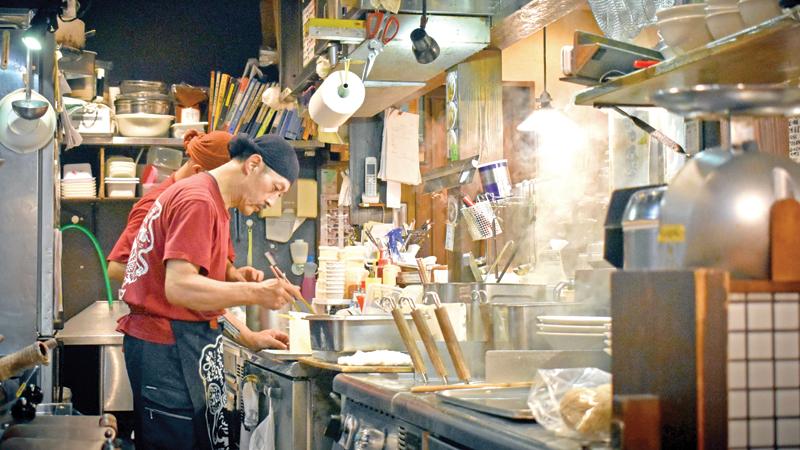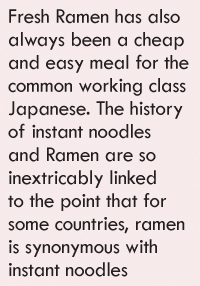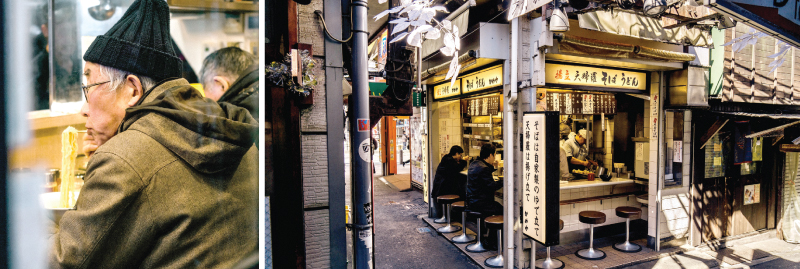
Ramen is a popular Japanese noodle soup dish that, through cultural osmosis, has become a world famous food item synonymous with Japan.
On the other hand, there’s instant noodles, a dried and precooked block of noodles packaged with a flavour packet, which became a world wide staple favoured for its convenience and affordability. At first glance, the globally cheap and easy instant noodle doesn’t have that much in common with the world famous Japanese noodle dish, which is typically a relatively luxury item outside of Japan.
However, Fresh Ramen has also always been a cheap and easy meal for the common working class Japanese. The history of instant noodles and Ramen are so inextricably linked to the point that for some countries, ramen is synonymous with instant noodles.
 While it may seem like a traditional part of Japanese culture and history, Ramen is a relatively recent invention from just the past century, though its origins go far further back. The idea of a noodle soup dish was first thought up in China, with the Lamian.
While it may seem like a traditional part of Japanese culture and history, Ramen is a relatively recent invention from just the past century, though its origins go far further back. The idea of a noodle soup dish was first thought up in China, with the Lamian.
Lamian
The earliest recorded recipe for lamian dates back to 1504. The lamian, literally translating to pulled noodle, is considered to be the direct predecessor and inspiration for Ramen. As many Chinese immigrants contributed to cross cultural exchanges between China and Japan, it is difficult to pin down an exact moment when the lamian was introduced to the Japanese, but it is commonly agreed to have been around the late 19th or early 20th century.
This early version of Ramen, was not originally known by that name, instead being called Shina Soba, literally Chinese noodles. The word shina however, had offensive connotations and would eventually fall out of use, instead adopting the name Ramen, the Japanese pronunciation of the word lamian, during the 1950s.
Originally just a niche dish commonly a part of Chinese culinary establishments, Ramen would find explosive popularity in post WW2 Japan, when rice shortages led to the occupying US to supply the country with cheap wheat flour to combat starvation. That flour led to the immediate rise in Ramen stalls as the cheap dish became a vital source of food for the common people.
Even though outdoor food vendors were banned by the government, late food distributions meant that they relied on illegal food vendors, especially Ramen vendors, to survive. After vending restrictions were reduced, Ramen’s popularity would surge further and become permanently associated with Japanese urban life.
Instant noodles
The popularity of Ramen would then directly influence the invention of instant noodles. Momofuku Ando, a Taiwanese man who grew up under the Japanese occupation of the country, travelled to Japan in order to establish himself as a successful businessman during post war Japan.
In 1947, Ando would see a Ramen street vendor with a long line of customers waiting to be served, giving him the idea of providing pre-prepared ramen that people would not have to wait for. A decade later, through many months of personal trial and error experimentation, Ando developed the first ever instant noodle product, the Chikin Ramen, distributed by his own company, Nissin Foods, which still remains as the world’s top instant ramen producer in Japan.
Though the product was initially more expensive than a fresh bowl of ramen, it sold for its convenience. Nowadays, Nissin brand instant ramen costs a third of the real thing. Since its introduction, instant noodles have become an essential part of many households all across the world thanks to its affordability and quick preparation. Though the rise of health conscious eating means that fresh Ramen is seeing a resurgence even outside of Japan, the sheer unparalleled convenience of instant noodles will not fade any time soon.

